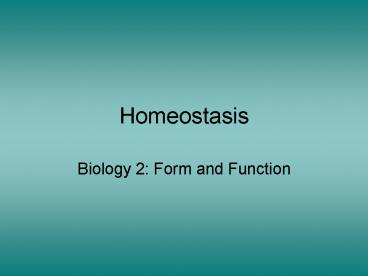Homeostasis - PowerPoint PPT Presentation
1 / 39
Title:
Homeostasis
Description:
Homeostasis Biology 2: Form and Function Overview Homeostasis = maintenance of constant internal environment Physiological controls Negative feedback loops Positive ... – PowerPoint PPT presentation
Number of Views:87
Avg rating:3.0/5.0
Title: Homeostasis
1
Homeostasis
- Biology 2 Form and Function
2
Overview
- Homeostasis maintenance of constant internal
environment - Physiological controls
- Negative feedback loops
- Positive feedback loops
- Behavioral controls
3
(No Transcript)
4
(No Transcript)
5
(No Transcript)
6
(No Transcript)
7
(No Transcript)
8
(No Transcript)
9
(No Transcript)
10
(No Transcript)
11
Osmoregulation
- Water is vital to the chemistry of life
- Therefore, must attain a water balance within the
body - Water balance systems are based on three
processes - Diffusion
- Osmosis
- Active transport
- Osmoregulation processes often tied to excretion
12
- Diffusion
- The spread of molecules along a concentration
gradient by brownian motion, towards a state of
entropy - Osmosis (the diffusion of water)
- Water moves from a low solute concentration
(hypotonic) to a high solute concentration
(hypertonic) - Active transport
- The movement of molecules across a membrane,
usually against a gradient, involving the
expenditure of energy
13
(No Transcript)
14
Osmoregulation in invertebrates
- Since most invertebrate phyla evolved in water,
no shortage - However, differences in concentration between the
cell and the solution surrounding it may cause
problems - e.g., Amoeba in freshwater hypertonic cell in
hypotonic solution - Result movement of water into cell
- Defense Contractile vacuole pumps out water
15
- Multicellular organisms use transport epithelia
to control water loss and excretion - Platyhelminthes
- Protonephridia (flame cells) collect excess water
in addition to nitrogenous wastes, empty into
nephridiopore, excretes NH3 - Annelida
- Metanephridia organized on a per segment basis
collect waste from coelom via the nephrostome,
counters water uptake by epidermis, excretes NH3 - Insecta
- Malpigian tubules collect nitrogenous wastes from
haemocoel, excretes Uric Acid
16
(No Transcript)
17
(No Transcript)
18
(No Transcript)
19
(No Transcript)
20
Osmoregulation in fish
- Depends on environment
- Freshwater
- Cells are hypertonic to environment, must defend
against water uptake - Excretion of dilute urine
- Mucous covering of epidermis
- Marine
- Cells are hypotonic to environment, must defend
against water loss - Water gain through food uptake and drinking
- Concentration of urine
21
(No Transcript)
22
(No Transcript)
23
(No Transcript)
24
(No Transcript)
25
(No Transcript)
26
(No Transcript)
27
(No Transcript)
28
(No Transcript)
29
Filtration
- Occurs in Bowmans capule
- Afferent arteriole from renal artery enters
glomerulus, exits via efferent arteriole - Blood filtered by capsule all non-cellular
products pushed into nephron (proximal tubule) - Filtrate includes products that must be retained
blood sugars, salts and vitamins
30
(No Transcript)
31
(No Transcript)
32
Secretion
- Occurs in proximal and distal tubule
- Secretion is initially active, although certain
molecular transport occurs passively as a result - e.g., NaCl actively pumped out, H2O follows
33
(No Transcript)
34
Reabsorption
- Materials that must be retained are brought back
by active transport or passive diffusion - Result of absorption/secretion in Loop of Henle
is highly concentrated urine - Nephron tubule is lined by transport epithelia
- Amount of water retained is controlled by
hormones that control activity of transport
epithelia
35
The Loop of Henle
- Descending limb is permeable to water but not
NaCl - H2O moves by osmosis to high salt concentration
in interstitial fluid - Thin segment of ascending limb is permeable to
NaCl which moves passively by diffusion to
equalize gradient - Thick segment of ascending limb actively
transports NaCl
36
(No Transcript)
37
(No Transcript)
38
(No Transcript)
39
(No Transcript)































